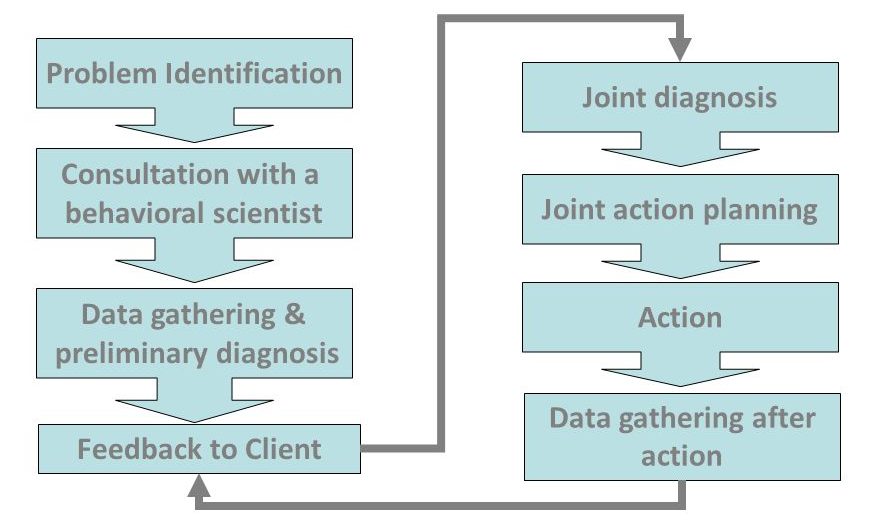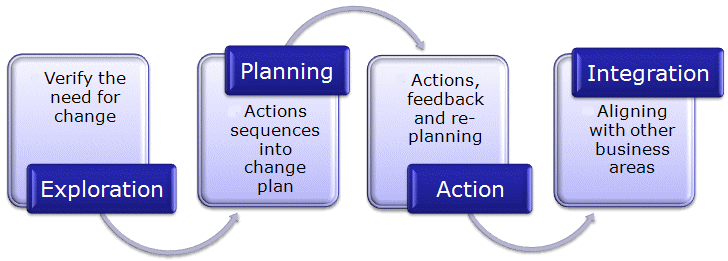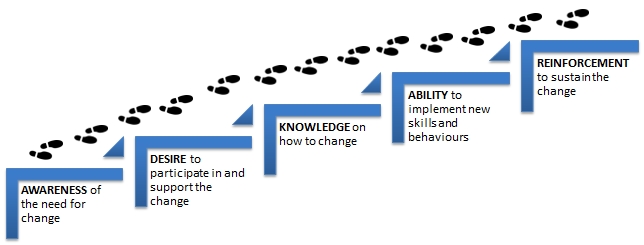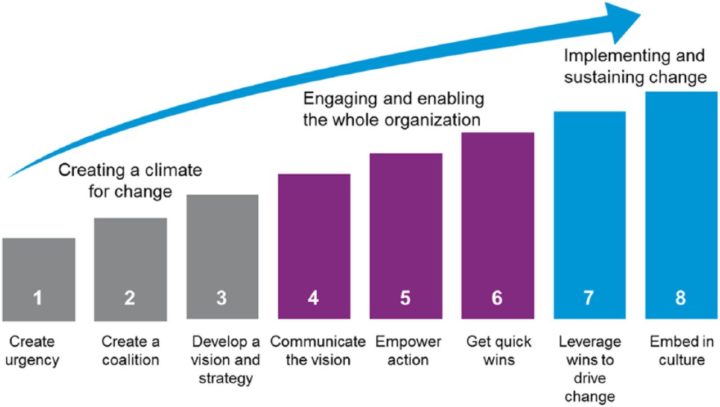Change whether planned or unplanned occurs in all organizations and at all levels. Change is inevitable and thus today many organizations prepare themselves for change. However the successful organization recognizes and understands the fact that change is not only inevitable it is also required in order to grow and stay ahead of competition. Therefore such organizations plan and implement change. Planning and implementing change requires the expertise of Organization Development experts who rely on certain models of change.
Some of the popular organization change management models, which have received attention globally, are:
1. Kurt Lewins Model of Change Management
One of the earliest models of planned change was put forward by Kurt Lewin in 1975. Lewin explained that organizations like human beings prefer to stay in a state of equilibrium or a steady state called as homeostasis. He observed that the stability of human behavior was based on “quasi- stationary equilibrium” supported by a large force field of driving and restraining forces. This observation gave rise to the theory of Force Field Analysis.
Kurt Lewin (1951) introduced the three-step change model. This social scientist views behaviour as a dynamic balance of forces working in opposing directions. Driving forces facilitate change because they push employees in the desired direction. Restraining forces hinder change because they push employees in the opposite direction. Therefore, these forces must be analyzed and Lewin’s three-step model can help shift the balance in the direction of the planned change
First stage: Unfreezing
According to Lewin, the first step in the process of changing behavior is to unfreeze the existing situation or status quo. The status quo is considered the equilibrium state. Unfreezing is necessary to overcome the strains of individual resistance and group conformity. Unfreezing can be achieved by the use of three methods.
- First, increase the driving forces that direct behavior away from the existing situation or status quo.
- Second, decrease the restraining forces that negatively affect the movement from the existing equilibrium.
- Third, find a combination of the two methods listed above.
Some activities that can assist in the unfreezing step include: motivate participants by preparing them for change, build trust and recognition for the need to change, and actively participate in recognizing problems and brainstorming solutions within a group.
Second Stage: Moving
Lewin’s second step in the process of changing behavior is movement. In this step, it is necessary to move the target system to a new level of equilibrium. Three ions that can assist in the movement step include: persuading employees to agree that the status quo is not beneficial to them and encouraging them to view the problem from a fresh perspective, work together on a quest for new, relevant information, and connect the views of the group to well-respected, powerful leaders that also support the change
Third Stage: Refreezing.
The third step of Lewin’s three-step change model is refreezing. This step needs to take place after the change has been implemented in order for it to be sustained or “stick” over time. It is high likely that the change will be short lived and the employees will revert to their old equilibrium (behaviors) if this step is not taken. It is the actual integration of the new values into the community values and traditions. The purpose of refreezing is to stabilize the new equilibrium resulting from the change by balancing both the driving and restraining forces. One action that can be used to implement Lewin’s third step is to reinforce new patterns and institutionalize them through formal and informal mechanisms including policies and procedures.
Therefore, Lewin’s model illustrates the effects of forces that either promote or inhibit change. Specifically, driving forces promote change while restraining forces oppose change. Hence, change will occur when the combined strength of one force is greater than the combined strength of the opposing set of forces.
The work of Kurt Lewin dominated the theory and practice of change management for over 40 years. However, in the past 20 years, Lewin’s approach to change, particularly the 3-Step model, has attracted major criticisms. The key ones are that his work: assumed organizations operate in a stable state; was only suitable for small-scale change projects; ignored organizational power and politics; and was top-down and management-driven.
Read More: Kurt Lewin’s Force-Field Theory of Change
2. Planning Model or Lippitt’s Phases of Change Theory
Lippitt, Watson, and Westley (1958) extend Lewin’s Three-Step Change Theory. They created a seven-step theory that focuses more on the role and responsibility of the change agent than on the evolution of the change itself. Information is continuously exchanged throughout the process. The seven steps are:
- Diagnose the problem.
- Assess the motivation and capacity for change.
- Assess the resources and motivation of the change agent. This includes the change agent’s commitment to change, power, and stamina.
- Choose progressive change objects. In this step, action plans are developed and strategies are established.
- The role of the change agents should be selected and clearly understood by all parties so that expectations are clear. Examples of roles are: cheerleader, facilitator, and expert.
- Maintain the change. Communication, feedback, and group coordination are essential elements in this step of the change process.
- Gradually terminate from the helping relationship. The change agent should gradually withdraw from their role over time. This will occur when the change becomes part of the organizational culture.
3. Action Research Model of Change Management
This model focuses on the cyclical nature of change. This model was mainly explained by Cummings and Huse and has eight steps.
- Problem Identification: This is the stage where a key person (maybe a top executive or the HR head or the CEO) senses a problem or an area of concern within the organization.
- Consultation with a behavioral scientist or an Organization Development consultant: In this stage the key person from the organization feels the need to take the help of an expert. This problem is discussed with an outside consultant, generally an Organization Development practitioner.
- Data Gathering and preliminary diagnosis: The consultant gathers data from employees, and other concerned parties using methods like observation, interviews, questionnaires and the analysis of data about organization performance.
- Feedback to organization: After collecting the data, and its analysis, the consultant gives feedback to the key person in the organization.
- Problem diagnosis: In this stage both the client and the consultant jointly discuss the feedback, and explore the actual situation and examine if any further research is needed.
- Joint action planning: The client and the consultant jointly agree upon an action plan and then make the necessary organizational processes prepared for the implementation of the plan. Various factors like cost, technology, organization play an important role in determining the action to be implemented.
- Action: This stage witnesses the actual implementation of the action plan. It may include installing new methods of work, simpler organization structures and work designs.
- Action review and data gathering. Once the action plan has been implemented, data is gathered again to asses the impact of the action plan. Based on the feedback, the action plan may be reviewed.
The action research model of implementing planned change is very useful for those organizations which want to implement change in a planned and phased manner. It also helps organizations to gather the relevant knowledge needed to revamp sagging organizational processes.
Read More: Action Research in Organizational Development
4. Integrative Model of Planned Change
This model was developed by Bullock and Batten and described the organizational state and the change processes. The basic premise of this model explains that since an organization exists in different states from one period to another, planned change can be implemented to move the organization from one state to another. The Integrative Model of Planned Change model consists of four stages.
- Exploration Phase: In this phase key persons from within the organization who are aware of the need for change act as the initiators. This stage is crucial since the organization examiners the requirement of change and what kind of investment in terms of resources can be made for the change programme. It is in this phase that the OD expert is identified .The consultant tries to examine the organizations inclination and commitment to change. The client on the other hand tries to judge if the consultant can understand the situation from the organizations perspective.
- Planning Phase: This phase follows the commitment of resources of the organization to change as well as the consultants’ exploration of the situation. The change process is undertaken after the diagnosis of the situation. The consultant as well as the client jointly participates in the diagnosis process, goals are set and an appropriate action plan is decided.
- Action Phase: The changes as decided in the action plan are implemented in this phase. The action plan includes basic actions and processes which take the organization from the present state to the desired state. Careful monitoring of the implementation couples with periodical assessment ensures that the organization is well set to achieve the desired action.
- Integration Phase: This phase involves making the changes part of the regular organizational functioning. Change in behavior and processes are reinforced gradually through feedback, reward systems, motivational techniques like incentives, participation in implementation etc. The consultant slowly moves away from the organization in order to ensure the organization can support itself in the future.
5. The ADKAR model of Change Management
The ADKAR model developed by Jeff Hiatt for individual change management presents five building blocks that an individual must obtain to realize change successfully. These include awareness, desire, knowledge, ability and reinforcement. It is management’s job to create an environment in which people can go through these stages as quickly as possible.
There are five steps in ADKAR model of change management:
- Awareness of the need for change – This involves understanding why a particular change is necessary is the primary aspect of a successful change. We here find out the rationale and need behind the change. So the employee will fully understand why change is necessary.
- Desire to participate in and support the change – Here the employee needs to make a personal decision to support the change and participate in the change. Only when the person is confident and convinced that the change is essential then only will he participate in the change activity. Proper incentives need to be formulated in order to motivate the person not to deter from the path of change.
- Knowledge on how to change – This is the third stage of the model in which knowledge about the change can be imparted through training, mentorship and other educational methods. Two types of knowledge needs to be addressed: knowledge on how to change (things to be done during the transition or the time during which the change is being implemented) and knowledge on how to perform after the change activity is implemented.
- Ability to implement required skills and behaviors – In this part of the building block Ability is referred to the difference between theory and practice. Once knowledge on how to change is in place then this is the theory being referred to and then comes the practical aspect which is the actual performance of the individual. This is a time consuming process and can be successfully implemented through practice, coaching and feedback.
- Reinforcement to sustain the change – In the final stage of the model there is an essential component in which efforts made by the individual to sustain the change are pressed upon. Here it is ensured that changes made stay in place and that the employee does not slip back to his old ways which can be ensured through positive feedback, rewards, recognition, measuring performance and taking corrective actions.
6. Kotter’s 8 step Model of Change
After Lewin’s model many other writers upgraded his theory making it more effective however the fundamental aspects were still there. One of the most popular model of change management is Kotter’s eight step model. According to Kotter, successful implementation of change depends on the eight steps as proposed by him. Skipping any one of the eight steps might create illusion of speeding of the process but it does not improve the effectiveness of change.
Kotter’s 8 step Model of Change include the following steps:
- Create a sense of urgency: This step includes analyzing the market and examining the possible risks and opportunities along with the competition in the market.
- Establishing the powerful group to guide the change: This step is to create a group which is capable to handle the changes and has enough power to lead the effort. The group should be encouraged to work as a team.
- Develop a vision: This stage includes creating a proper vision of change in the organisation. Apart from this the change should be highly focused and should be in rather simple form so that everyone understands and accepts.
- Communicate the vision: The vision that has been proposed has to be delivered or explained to everyone. A good communication of the vision is very important.
- Empower staff: The next step is empowering the staffs. This step includes removing hurdles in the change and encouraging new and unconventional ideas and ways of doing things.
- Ensure there are short terms win: It is very important to keep the staffs motivated. Short term wins help the staffs to remain motivated. This also helps the support needed for the change.
- Consolidate gains: Organisation should check the policies that inhibit or restrain the changes and if there are any, they should be changed. The policies that catalyze the changes should be brought in to action to speed up the change and efficiency.
- Institutionalize the change in the culture of the organisation: the changes that have been made should be institutionalized or embedded in the organisation as a culture and should be linked with the performance and leadership.
The first four steps of Kotter’s eight model act as a defroster a hardened equilibrium. Stages five to seven is the introduction of many new changes. It resembles with the change phase in the Lewin’s model. The last phase grounds the changes that have been made into the business or organisation culture. The success and improvement of the organisation depends on the proper follow of the sequence.
Read More: Kotter’s 8 step Model of Change




